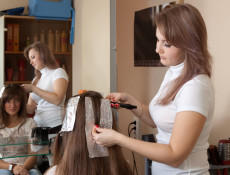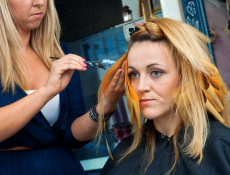A Healthy “Correction”
Nobody wants to hear that their hair needs “correction”. I mean, who wants to be “corrected”…Ever?
In the salon world, it sounds like a nice way to say that your hair is in big, big trouble and it will cost you an arm and both legs to make it happy again.
But what really makes color “corrective”, anyway?

In its simplest form, corrective color means a huge, drastic, or monumental hair change. Color Correction can be used to help little Sally-swims-a-lot look more like a little girl again, and less like the blonde-green, chlorine “Swamp Thing” (If you don’t know who he is, I encourage you to explore). It is also for the day that Morticia Adams comes into salon “X” and wants to look like Marylin Monroe , or when that girl-next-door, Reese Witherspoon, decides to tap into her inner Kim Kardashian.
In short, It isn’t always as scary as it sounds, and it doesn’t always mean that your hair is beyond repair. You can relax now. You won’t need to stroke your hair goodbye, unless….
1. Your hair IS actually beyond repair. It may be true that your hair is compromised to such an extreme, that hair color anywhere within a 3 mile radius, could send your tresses packing and off to happier lands. Your hairstylist will be able to determine this during a consultation and get you on a healthy hair regimen that will suit your needs.
OR
2. You make poor and unhealthy hair choices in your journey from That’s So Raven Black to Kate Bosworth’s Bombshell Blonde. Healthy hair can be compromised if it is pushed to unreasonable limits all at once. This can also be determined during a color consultation.
So, What is my point? I used the word Journey above, because that is how I encourage my clients to think about their transformation. While I love and inspire change for my clients, I am not willing to use any means that will compromise their hair’s integrity.
Let’s talk about healthy hair for a minute. See, I’m a hairstylist, and If people don’t have “hair” after my service, I have no hair to style. Not only do I want to ensure that the hair stays ON their head, but I want it to look and feel it’s absolute best. A Client’s head is like a walking billboard, displaying their stylist’s talent everywhere they go. Therefore, I want my client’s to have the sort of happy tresses that style easily and turn heads at the grocery store. This way, we both win.
To the hairstylists: During a consultation, be honest with your client about what is a reasonable expectation for their color service. Don’t be afraid to say “no” to a request that you are uncomfortable with, or unable to perform. I have learned that the disappointment of rejection before the service is far better than the disappointment they will feel once you’ve promised something and failed to deliver. Feel the hair to determine its current condition, try to imagine how it might change after the service, then prepare them for that change.
If your client’s hair isn’t suited for a drastic and immediate change, you might suggest that they embark on a hair “journey” with you, rather than a quick sprint. You may say something like: “I think that color will look great on you, but let’s take it in steps, and see how many great looks we can hit along the way! Using this method, your hair will be it’s absolute healthiest when we reach your goal.” They may find that their best look is somewhere between where they started and what they thought they wanted.
Here are a few subtle techniques I use to help “corrective clients” ease into a new look:
Going a little Lighter:

a. Use foiling to add panels of lightener nearly horizontal, but at a slight diagonal, at the part line. Process and then tone to the desired shade. this will lighten the hair at the partline where it is most noticeable, while maintaining some of their existing color and preserving hair health underneath. (not suitable for drastic color changes.)
b. Lightening the ends of “too dark”, solid-looking hair can brighten it up just enough, and give it a more natural appearance.
Going Darker:

a. Add panels of lowlights throughout the hair and then tone everything else a shade or two darker with a semipermanent color. The semipermanent color will fade over time, making it a great way to ease someone into the idea of a darker hair color without the commitment.
b. Another way to prepare someone for darker hair is with a smudged root look. Select a deeper base color (1-2 levels darker) and use your fingers or a color brush to blend the color out from the base and towards the midshaft. Leave the ends out or deepen them slightly, smudging the color together where it meets to soften.
Whether you’re taking a short trip for a quick hair change, or a long voyage towards a completely new look, be kind to your hair, keep it healthy, and everyone will be happy.